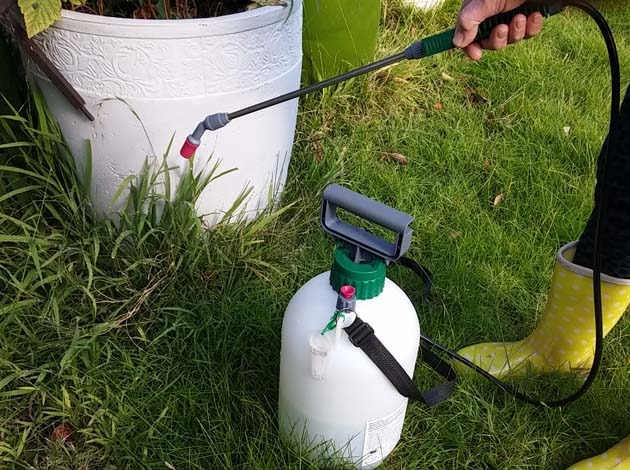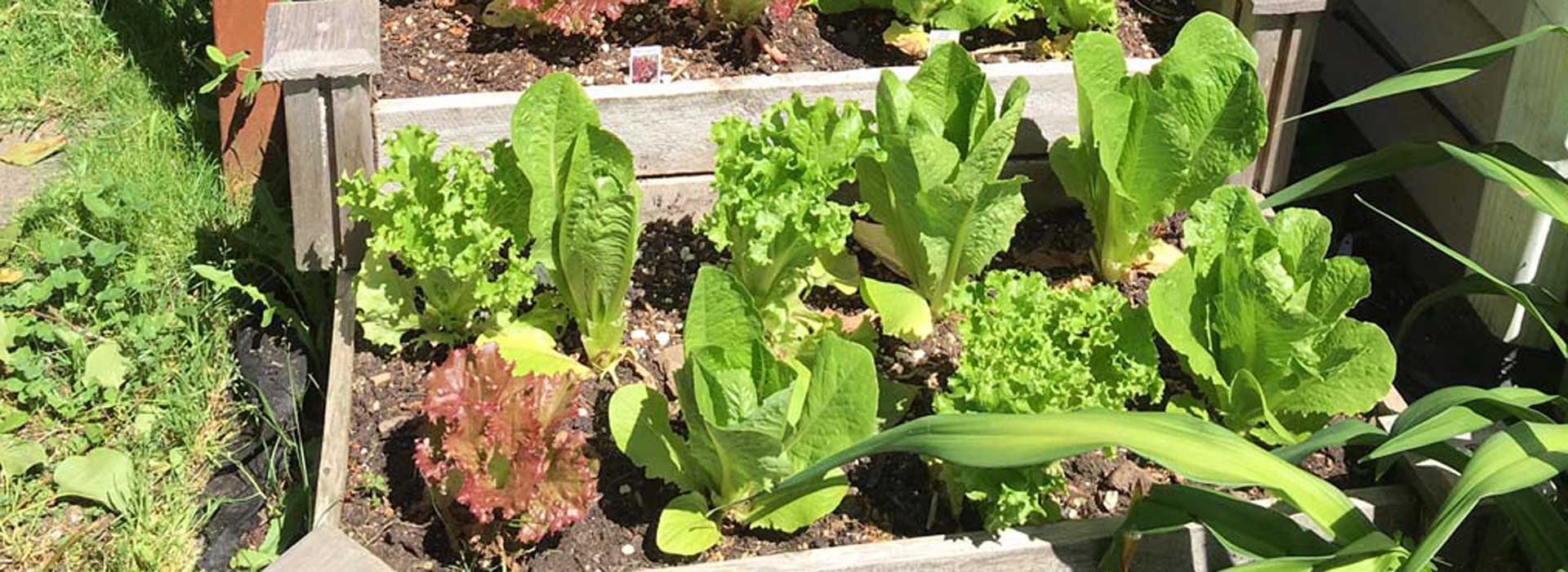Bare Root Fruit Trees
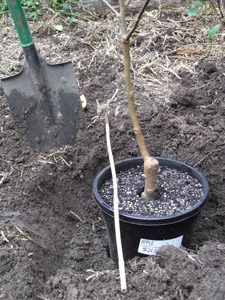 Everything you need to know about bare root fruit trees
Everything you need to know about bare root fruit trees
As the weather gets colder, it’s ever so tempting to stay inside, and curl up by the fire with a glass of wine and your media of choice. However, winter is a top time in the garden, especially if you are planning on planting some fruit trees to feed you for years to come. And while this can seem daunting (and somewhat unappealing in chilly weather), edible trees are a must have in every productive patch, and winter is the time to get down and dirty with deciduous fruit trees. The following guide contains everything you need to know about picking, pruning, planting and pampering beaut fruit trees! It’s time to whack on the winter woolies, and get amongst it!
Finding Fruit to Fit
Now, before you make the carbon neutral trip down to the local garden centre and select a swag full of fruit trees, you need to have a look at your patch. There are a few things to look out for, many of which will significantly influence which fruiting beauties you select. In your patch, have a look at how much space you have for a fruit tree, bearing in mind that many varieties require a friend or two to pollinate (don’t we all?) which will require more room. The bulk of fruit trees require full sun for optimum performance, and many can get to a fair height, so remember to look up as well as down. Are you wanting to espalier the tree (that is, train it to grow “flat” along a wall or fence), grow it in a pot, or use it as a feature?
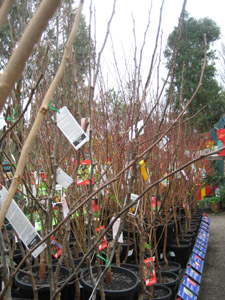
Remember that while the deciduous trees are leafless over winter, this will alter come spring, meaning sun underneath may disappear in the warmer months. This is particularly important if you are considering whacking in a Yummy Yard in close proximity to the tree. Yeah, it’s a lot to consider, but there really is a fruit tree for every space... you just have to be realistic about room (trust me, it’ll save tears later on!). Oh, and it is essential to match your fruit tree selections with your climate – there are some plants that just aren’t supposed to grown in some spots!
Picking the Perfect Plant
Now that you have assessed the patch and planned your purchases, it’s time to head to the garden centre and pick out your plants. Despite what you may have heard, bigger is not always better, and canny customers will generally select small to medium size bare root fruit trees, rather than the biggest on the bench. Shape is also an issue, and if you are wanting to purchase a peach, persimmon, nectarine, plum, pear, apple, almond or apricot, look for plants that lend themselves to a nice “vase” shape. This vase shape is perfect for allowing good air circulation, which may not be an issue when the trees have no leaves, but will prove most beneficial when the foliage returns. If you are selecting a tree for espaliering, it’s time to click here to head to the espalier page... otherwise read on.
These days, many bare rooted trees are whacked into pots, to make displaying and transport easier (they used to be sold with no pots, generally covered in sawdust and wrapped in newspaper). Just because they are in a pot doesn’t mean they can stay there, so don’t purchase a plant until you are ready to put it into the ground (or a bigger pot with top notch organic potting mix). Make sure you buy current seasons stock... that is, one where the roots look healthy, and the plant isn’t pot bound. Pick a plant that looks vigorous, has a nice shape, no visible damage to branches and trunk, and appears free of blemishes.
Remember that many fruit trees need pollinators (friends that help them fruit) so ask your nursery person for suitable varieties for the trees you have chosen. Nowadays, there are many varieties of trees available that are self-pollinating (no, it won’t make them go blind) and a huge selection of multi-grafted fruit trees. Multi-grafted trees are those that have either two or three (and occasionally more) different varieties of the same fruit on one tree, and can seriously save you space in the garden.
Pruning for Productivity and Prettiness
Ok, let’s get serious now. Fruit trees require pruning to maintain the health and vigour of the tree, as well as to encourage fruit production, which is why we plant them in the first place! Regular pruning opens up the canopy allowing greater air circulation and more light, meaning a healthier, problem free tree in the future. An added bonus of pruning means the size of the tree is restricted, and the fruit is easier to pick each season.
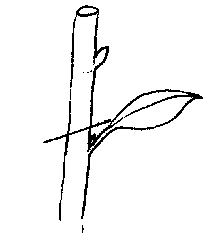
As long as pruning cuts are made in the correct position and cleanly, the plant will heal. Using special paint to seal the cuts is generally not necessary, if the cuts are made correctly with clean pruning equipment. Always use pruning equipment appropriate to the size of the branches you will cut, selecting between secateurs, loppers and pruning saws. When tying up stems, use soft flexible ties and allow for some movement of the stem. Remember to regularly check and remove ties, as these can cause terrible injury and amputation to plants if they are left unchecked.
Positioning the prune: When making pruning cuts on smaller stems and branches, the position of the cut is just above a node (see diagram 1). A node is where a bud, leaf or stem emerges from a branch. The internode is the space along the branch between the nodes. If the cut is made too far into the internode, then the branch usually dies back to the node. This area of die back is a potential entry point for disease, and can spell trouble in the years ahead.
Despite what you may have heard, the angle of the cut is not as important as getting the position right. Ideally, the cut should angle slightly away from the bud so that water is directed away from the bud, minimising the risk of infection. Also, you should try not to cut on a sharp angle as this makes a large wound and may damage the bud.
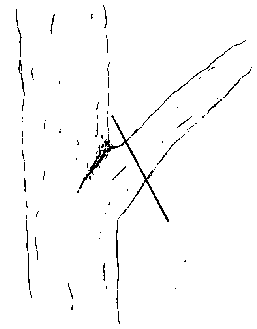
When pruning main branches, the cut should be positioned so that the branch - bark ridge (the ridge of bark on the top where the branch is attached to the trunk) and the collar (swollen area underneath the attachment point of the branch to the trunk) are not damaged. Even if you cannot see it, the collar is still there and should not be damaged. The pruning cut should be made just outside this area (see diagram 2).
Why bother? In addition to encouraging fruit production, fruit trees require regular pruning to remove dead or diseased branches, remove branches that cross over, keep the centre of the plant open, shape them up, and to thin out the fruit. Pruning is an ongoing activity, and one that must be conducted at least annually to ensure awesome trees and full-on fruit. For most deciduous fruit trees, the best time to give them a haircut is during their winter dormancy, unless you are growing apricots, who like their annual chop in early autumn, while there are still leaves on the plant.
Planting the Plant
Planting bare root fruit trees is all about tenderness and technique, so don’t just throw it into a hole and walk away. That said, don’t leave the trees sitting in their pots for an extended period of time either – bare root fruit trees should only be purchased if you are planning on planting them almost immediately. Once the plant has been pruned, remove it from it’s pot, and soak the roots in a bucket of water for about two hours (add a small amount of seaweed fertiliser or compost tea to this if you feel so inclined). While the tree is soaking, it’s time to dig a hole.
Head out to the prepared patch, and dig a whole twice as wide as the pot, but no deeper. The idea is here that we do not want to plant the tree any deeper than the existing soil line in the pot, to minimize the risk of disease, issues and collar rot (think plant tinea... not good!). The inside of the hole should have nice, rough edges, to ensure the effective movement of water, air and allowing our precious little plant roots to spread. Once prepared, fill this hole with water, and allow to drain away naturally – this minimizes transplant shock, and will give your tree the best start in life.
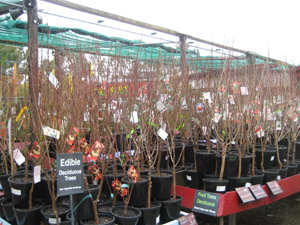
Once this water has drained away, it’s time to pop the plant in place. Gently tease out the roots of the plant to minimize the risk of root girdling (when roots wrap around each other and the trunk of the tree, and effectively squeeze the life out of them!). Back fill the hole, lightly firm the soil, and water in. Whack some mulch down next, taking care to keep the mulch well away from the stem of the plant. And that’s it! You’ve planted a bare root fruit tree!
Pampering and Preventing Pesky Problems
Even without their leaves, your deciduous fruit trees need a little loving! Winter washing is a great way to prevent funky fungal issues, like Peach Leaf Curl, affecting your fruit trees, particularly stone fruits (including peaches, nectarines, apricots and almonds). Winter washing involves spraying your trees with a low environmental impact copper oxychloride or lime sulphur spray, several times over the winter dormancy period, until bud burst. What this does is prevent fungal spores from taking hold, and will go a long way to preventing issues come spring time.
As the weather warms up, you may see your young fruit trees burst into flower and start to put on fruit. While this is indeed a very exciting time (your first home grown fruit... woohoo!), you must remember that in the first and second seasons, it is best to remove fruit from the tree as it forms. This allows our newly planted fruit trees to spend their valuable energy and nutrients on getting established, rather than producing fruit. While this can be difficult, you will benefit in seasons to come from a well established, healthy plant that provides a luscious load of full flavoured fruit!
Bare root fruit is beaut, and a couple of trees are a great way to ramp up the productivity in your patch! Quite honestly, there is nothing as rewarding as picking, eating and sharing your home-grown harvest. Get on a winner this winter; go for some bare root fruit!
Are glyphosate products safe to use?
Unless you follow the news in detail you might not know about current debates regarding the weed killer, glyphosate, widely used in garden products and in agriculture.
Well, there is a lot going on – here is just a summary of the very large amount of material reported globally.
What is glyphosate?
Based on the amino acid, glycine, which is part of almost all proteins, its composition is usually referred to as N-(phosphonomethyl)glycine) or 2-[(phosphonomethyl)amino]acetic acid. One method of industrial preparation is to modify the naturally occurring amino acid, glycine1, which is one of the building blocks of biological proteins. Glyphosate blocks the production of other amino acids phenylalanine, tryptophan and tyrosine which means that it stops plants from making proteins. Thus growth stops and the plant dies. Effectiveness is, therefore, greatest when sprayed on leaves of actively growing plants. Commercial use as Roundup was started by Monsanto in 1974.
Although it is used at different times during crop growth, it is often used quite close to harvest – in the USA, as close as 3 days before. In Australia, registered usage is allowed up to 5 or 7 days before harvest of wheat depending on the particular formulation. 2
Usage
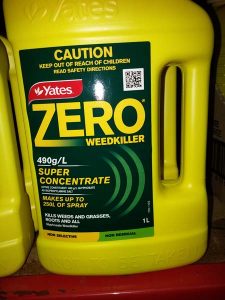 Because of its effectiveness it now represents 53.5% total agricultural herbicide use in the USA 3. This effectiveness is partly due to the development of genetically-engineered crops which are resistant to it so it can be sprayed on the entire crop to kill weeds, even shortly before harvest. This means that there is an increased likelihood of glyphosate residues being present in harvested material. Around 93% of soybeans and 89% of corn and cotton crops in the USA are genetically engineered so that they are not sensitive to glyphosate3.
Because of its effectiveness it now represents 53.5% total agricultural herbicide use in the USA 3. This effectiveness is partly due to the development of genetically-engineered crops which are resistant to it so it can be sprayed on the entire crop to kill weeds, even shortly before harvest. This means that there is an increased likelihood of glyphosate residues being present in harvested material. Around 93% of soybeans and 89% of corn and cotton crops in the USA are genetically engineered so that they are not sensitive to glyphosate3.
Since Monsanto’s patent for Roundup expired in 2000, it is now sold under a variety of brand names by both Monsanto and other agricultural/garden product manufacturers. In Australia, products for agricultural use include Weedmaster Duo, Roundup, Zero as well as many more generic brands such as Glyphosate 450.
The Australian Pesticides and Veterinary Medicines Authority (APVMA) currently lists 539 registered products which contain glyphosate4. Many have glyphosate in their names, others include Roundup, Zero and a variety of products with the manufacturer’s name followed by something like “weedkill concentrate”. Around 20 of those are available for garden use. We have been unable to find a reliable figure for the percentage of agricultural herbicide that involves glyphosate products in Australia. It is commonly used by local councils on public land5.
Safety Issues
There are stacks of material written about glyphosate with arguments for and against it. A large proportion comes from blogs, websites, the news media or government and manufacturers’ sources. We will refer to some of those here, but have tried to concentrate on material that has been reported or backed up in scientific literature which has been reviewed by scientific peers. That is not to say that blogs and news items are incorrect, but that, with so much debate, properly validated studies should be given priority.
Levels in the Environment
Glyphosate was found in the air and rain by scientists from the US. Geological Survey and the
School of Public Health, Minnesota6. Although it was not possible to measure the percentage of sprayed glyphosate that ended up in the air, they estimated that 0.7% of application is removed from the air in rainfall. They detected glyphosate in 60 – 100% of their samples in Indiana, Iowa and Mississippi. This reflects observations by a number of researchers that a large range of pesticides, herbicides and fungicides are found in rain. For example, a study in 4 areas in the USA testing for 82 different chemicals showed their presence in rain at each of the 4 sites. Most were herbicides with metolachlor and atrazine being the most frequently found7.
Glyphosate has also been detected in groundwater in a number of studies such as the most recent In Mexico where levels were 1.42 μg/L. It was also present in urine (0.47 μg/L) from local subsistence farmers8.
Levels in food
An extensive report by Food Democracy Now and the Detox Network 5 in the USA quote results of measurements made by Anresco Laboratories showing levels as high as 1125.3 parts per billion (ppb) in Cheerios (an oat cereal) and between 200 – 400 in many other cereal products. The USA Food and Drug Administration has not tested levels in food.
Health Effects
The big question is whether glyphosate harms us. Some studies suggest that it could. But clear conclusions are difficult to reach because of conflicting reports on what levels of exposure are acceptable and the difficulty of proving causation in humans.
Carcinogen
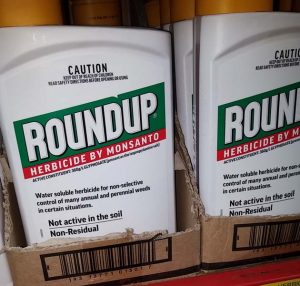 In a review of dozens of studies the International Agency for Research on Cancer (IARC) (an agency of the World Health Organisation (WHO)) concluded in 2015 that there was significant evidence that glyphosate was carcinogenic in rats and a probable carcinogen (for non-Hodgkin’s lymphoma) in humans. And the USA EPA Office of Research and Development came to the same conclusion. However, the European Food Safety Authority and the EPA Office of Pesticide Programs came to the opposite conclusions9, 10.
In a review of dozens of studies the International Agency for Research on Cancer (IARC) (an agency of the World Health Organisation (WHO)) concluded in 2015 that there was significant evidence that glyphosate was carcinogenic in rats and a probable carcinogen (for non-Hodgkin’s lymphoma) in humans. And the USA EPA Office of Research and Development came to the same conclusion. However, the European Food Safety Authority and the EPA Office of Pesticide Programs came to the opposite conclusions9, 10.
Kidney disease
Chronic kidney disease in farmers in Sri Lanka and El Salvador is suggested to be associated with a combination of glyphosate and hard drinking water11. However, causation has not yet been proven.
Endocrine disruption
Laboratory studies such as that on cell lines12 show that glyphosate can act as male hormone disruptor. Similar effects have also been found in frogs.
Antibiotic properties
When grown in the laboratory in the presence of glyphosate, common bacteria such as E.coli and Salmonella Resistance have shown resistance to antibiotics13. It is not clear if similar effects result in humans or other animals.
Evolution of Resistant Weeds
Other concerns have been raised about increasing resistance of weeds to glyphosate. Just as over use of antibiotics to treat human disease is causing the development of resistant “super-bugs”, the prevalence of glyphosate use is causing resistant weeds to appear. In the USA 15 weeds species have developed resistance14. In Australia, 6 weed species are resistant to glyphosate15. This means reduction in crop yields or the use of herbicides which have known greater environmental or health impacts.
Reevaluation, Law suits and Regulations
Both community and academic researchers are calling for more research5, 16. Regulatory bodies in different countries have made different responses. In the USA many lawsuits were started by sufferers of non-Hodgkins lymphoma.
In March, 2017, after the IARC and EPA Office of Research and Development decided that glyphosate was a probable carcinogen, a judge in California ruled that it should be listed as such in that state. However, Monsanto disputed the decision and discounted or disagreed with research like that described above, and sued claiming that the ruling was unconstitutional.
Because evidence of risk of using glyphosate, action has been taken in many countries to restrict or ban its use. Unfortunately, there is confusion about action different countries have taken because of some misleading media reports. However, it seems the case that, the Netherlands has banned its use by individuals, Sri Lanka has banned all use and the major supermarket chains in Switzerland will no longer sell any product containing it17. In the European Union, discussion is still ongoing.
After the WHO decision, at least 60 individuals and groups in the USA have filed lawsuits against Monsanto. Subsequently, there have been claims that the section of the EPA which had found glyphosate safe was colluding with Monsanto with a subsequent official enquiry18.
The EPA has been preparing a risk assessment of glyphosate since 2015, but it has not yet been published.
In Australia, the Australian Pesticides and Veterinary Medicines Authority (APVMA) reviewed the IARC/WHO report in September 2016 and concluded that glyphosate does not pose a cancer risk19.
Should gardeners use it glyphosate products?
Because of these debates and lack of consistent regulation, making this decision is a personal choice based on documented risks and your views on chemical use in general. SGA recommends that priority be given to using non-chemical methods i.e. planting ground covers, applying heavy mulch to minimize weed growth and, if necessary, removal by hand.
References
1. Dill GM, Sammons RD, Feng PC, Kohn F, Kretzmer K, Mehrsheikh A, Bleeke M, Honegger JL, Farmer D, Wright D, Haupfear EA (2010). "Glyphosate: Discovery, Development, Applications, and Properties"http://media.johnwiley.com.au/product_data/excerpt/10/04704103/0470410310.pdf
2. Grains Research and Development Corporation. 2014
https://grdc.com.au/__data/assets/pdf_file/0027/126477/grdc_fs_pre-harvest-herbicide-pdf.pdf.pdf
3. United States Department of Agriculture. 12-07-2017. https://www.ers.usda.gov/data-products/adoption-of-genetically-engineered-crops-in-the-us/recent-trends-in-ge-adoption.aspx
4. https://portal.apvma.gov.au/pubcris?p_auth=ObRVUmz0&p_p_id=pubcrisportlet_WAR_pubcrisportlet&p_p_lifecycle=1&p_p_state=normal&p_p_mode=view&p_p_col_id=column-1&p_p_col_pos=2&p_p_col_count=4&_pubcrisportlet_WAR_pubcrisportlet_javax.portlet.action=search
5. Murphy D, Rowlands H. 2016. Glyphosate: Unsafe on any Plate. Food Testing Results and Scientific Reasons for Concern. https://s3.amazonaws.com/media.fooddemocracynow.org/images/FDN_Glyphosate_FoodTesting_Report_p2016.pdf
6. Chang F-C, Simcik MF, Capel PD. 2011. Occurrence and fate of the herbicide glyphosate and its degradate aminomethylphosphonic acid in the atmosphere. Environmental Toxicology and Chemistry 30, 548–555.
7. JRVogel, MS Majewski, PD Capel. 2007. Pesticides in Rain in Four Agricultural Watersheds in the United States. Journal of Environmental Quality 37, 1101-1115
8. J Rendón-von Osten, R Dzul-Caamal. 2017. Glyphosate Residues in Groundwater, Drinking Water and Urine of Subsistence Farmers from Intensive Agriculture Localities: A Survey in Hopelchén, Campeche, Mexico. International Journal of Environmental Research and Public Health 14(6), 595; 9 CJ Portier, BK Armstrong, BC Baguley, et al. Differences in the carcinogenic evaluation of glyphosate between the International Agency for Research on Cancer (IARC) and the European Food Safety Authority (EFSA) Journal of Epidemiology and Human Health 70, 741-745.
9. Portier CJ, Armstrong BK, Baguley BC et al. Differences in the carcinogenic evaluation of glyphosate between the International Agency for Research on Cancer (IARC) and the European Food Safety Authority (EFSA). Journal of Epidemiology and Human Health 70, 741-745.
10. Sass J. 2017. https://www.nrdc.org/experts/jennifer-sass/split-within-epa-glyphosate-carcinogenicity
11. C Jayasumana, S Gunatilake, P Senanayake. 2014. Glyphosate, Hard Water and Nephrotoxic Metals: Are They the Culprits Behind the Epidemic of Chronic Kidney Disease of Unknown Etiology in Sri Lanka? International Journal Environmental Research and Public Health 2014, 11(2), 2125-2147.
12. Gasnier C, Dumont C, Benachour N, Clair E, Chagnon M-C, Séralin G-E. 2009. Glyphosate-based herbicides are toxic and endocrine disruptors in human cell lines. Toxicology 262 (3) 184-191.
13. Kurenbach B, Marjoshi D, Amábile-Cuevas CF, Ferguson GC, Godsoe W, Gibson P, Heinemann J. 2015. Sublethal Exposure to Commercial Formulations of the Herbicides Dicamba, 2,4-Dichlorophenoxyacetic Acid, and Glyphosate Cause Changes in Antibiotic Susceptibility in Escherichia coli and Salmonella enterica serovar Typhimurium. mBio 24th March.
14. Wechsler SJ, McFadden JR, Smith DG. 2017. What do Farmers’ Weed-Control Decisions Imply about Glyphosate Resistance? Evidence from Surveys of U.S. Corn Fields. Pest Management Science Accepted Author Manuscript. doi:10.1002/ps.4598.
15. Mechelle Owen, Dr Chris Preston and Associate Professor Steve Walker. Resistance Rising across Australia. GroundCover™ Herbicide Resistance. Supplement Issue: 104
16. Vandenberg LN, Blumberg B, Antoniou MN, et al 2017. Is it time to reassess current safety standards for glyphosate-based herbicides? Journal of Epidemiology and Community Health 71, 613-618.
17. Baum, Hedlund, Aristei & Goldman 2017. Monsanto Roundup Lawsuit. https://www.baumhedlundlaw.com/toxic-tort-law/monsanto-roundup-lawsuit/
18. The EPA's Inspector General Is Probing Whether an Agency Staffer Colluded With Monsanto. June 2017. http://www.huffingtonpost.com.au/entry/epa-inspector-general-probing-collusion-with-monsanto_us_59372108e4b0aba888b99dca
19. ABC News Report. 2016. http://www.abc.net.au/news/2016-02-16/councils-still-using-herbicide-that-probably-causes-cancer/7168464
20. Australian Pesticides and Veterinary Medicines Authority. 2017. https://apvma.gov.au/node/13891
Review of "The Kew Plant Glossary"
 Robyn Wing has reviewed the second edition of this informative book written by Henk Beentje.
Robyn Wing has reviewed the second edition of this informative book written by Henk Beentje.
Publisher: Kew Publishing, Royal Botanical Gardens, Kew, 2016.Read more
Review of "Preserving the Italian Way"
This 264 page book provides a comprehensive coverage of methods to preserve a vast range of foodstuffs with a focus on traditional Italian approaches. It has chapters on preserving in oil or vinegar, wild mushrooms, olives, fish, cheese, sauces, salami and roast meats, liqueurs, wine, syrups, drying, bread, herbs and soap. Recipes for preserving in oil are given for eggplant, zucchini, cauiflowers, chocos, tomatoes, carrots, globe artichokes, mushrooms, Scottish thistle, gherkins, beans, capsicum and peppers, while methods of preserving carrots, cauliflowers, cucumbers, onions, beans, peppers, capsicum, eggplants, celery, globe artichokes, turnips, cabbage, mushrooms and mixed vegetables in vinegar are also provided. There is also a recipe for candied pumpkin.
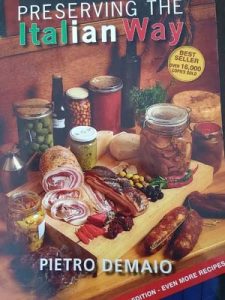 Written and self-published by Pietro Demaio, 5th edition, 2009As well as general guidelines for preserving olives, there are 20 recipes for preserving them addressing methods using salt, salty brine, caustic soda or brine and vinegar. What more could you want!
Written and self-published by Pietro Demaio, 5th edition, 2009As well as general guidelines for preserving olives, there are 20 recipes for preserving them addressing methods using salt, salty brine, caustic soda or brine and vinegar. What more could you want!
Gardeners might not be so interested in preserving meats and fish unless you make a cheap bulk buy, but these chapters, together with those on sauces, liqueurs and herbs might give you new ideas on how to use materials you have in excess at certain times of the year.
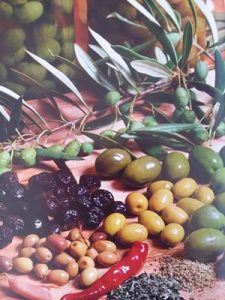 I particularly like the chapter on olives. So many recipes to choose from according to the particular taste you like. My daughter has a mature olive tree and I have a three-year-old tree which has just produced its first crop – 600 g of lovely fruit, so I’ve tried some of those recipes out.
I particularly like the chapter on olives. So many recipes to choose from according to the particular taste you like. My daughter has a mature olive tree and I have a three-year-old tree which has just produced its first crop – 600 g of lovely fruit, so I’ve tried some of those recipes out.
There are some additional detailed notes at the end as well as an index of recipes.
The book is written in an engaging, chatty style which makes reading a pleasure.
Its one disadvantage for me is that it is limited to Mediterranean fruit and vegetables, which I suppose you’d expect from the title. I would like to read of the same depth of knowledge and experience given to fruit and vegetables which grow elsewhere. But a very useful book!
Review by Sharron Pfueller
Some SGA people
Who are the people who bring Cuttings and web articles to you? And keep our office, website and social media going?
We are largely volunteers who are passionate about gardening and contributing to protecting the natural environment. Because SGA is a not-for-profit organisation we are reliant on donations to fund our work. That means we can only afford to pay a few staff for a few hours per week and still keep all those boring but essential things operational, such as office equipment, phone and insurance.

Our volunteers are a mixed bunch – here is a rundown on some of them:
An IT manager of a large company who took early retirement. She wants to keep her mind active and contribute to SGA’s skill and knowledge base – passionate about gardening and the local community garden.
 A semi-retired lawyer who loves doing background research and finding clever ways of doing things. She also doesn’t mind contributing legal knowledge or doing repetitive tasks such as making sure our website is optimized for search engines.
A semi-retired lawyer who loves doing background research and finding clever ways of doing things. She also doesn’t mind contributing legal knowledge or doing repetitive tasks such as making sure our website is optimized for search engines.
A retired IT expert, keen on gardening, who is helping with aspects of our IT systems.
A retired atmospheric scientist who wants to keep using his scientific skills and contribute to protecting the environment. He helped create and now updates the database behind our WiseGardening app.
A semi-retired business owner with a background in landscaping and economics – shares management and oversees our subscriber database, IT systems and fledgling program for the gardening industry.
An agronomist between jobs – keen on environmental matters and helping keep the garden product database up-to-date.
A retired biochemical and environmental scientist – CEO, author, maintains website, create content and the WiseGardening app.
Most of our volunteers contribute about 1-4 hours per week – some up to 40 (they’re the obsessive, crazy ones!) More on our other volunteers in the future . . . .
To help provide the facilities keep our office going, we'd love it if you were able to make a tax-deductible donation - DONATE HERE.
If you’d like read more about what we’ve been doing in the last year, it's in our (not very long) Annual Report.
Mountain Black Pepper
One of SGA’s subscribers, Zeljko Horvatin, is a chef and is studying horticulture. He writes:
Over the last couple of years, while studying, I’ve learnt to appreciate and have even fallen in love with Australian native plants and, in particular, bushfoods. Being a chef and a gourmand switches my brain into food mode with whatever I work with. So it follows that I’ve become fascinated with how Australian native plants can be part of the menu as well as part of the garden.
My first bush tucker experiment was with Tasmannia lanceolata, also known as the Mountain Pepper.
The plant
There’s a lot of information out there about the plant in books and the internet. They all agree that T. lanceolata is a large shrub or a small tree, but when it comes to its size, there’s a range of views, suggesting that the plant grows to anywhere between three and ten meters. These discrepancies should not be a problem, unless you are short of space. I guess it can be pruned, especially if you are going to use it in cooking.
Used by Aboriginals as both food and medicine, the plant belongs to the Winteraceae family which is part of the group of plants known as palaeodicots, which are considered amongst the most primitive flowering plants because of their floral anatomy and wood structure. It is native to Tasmania and the Australian mainland, where it is mostly found in Victoria and southern NSW. It thrives in cool moist environments, in either sun or shade with well-drained soil.
The leaves are glossy dark green, narrowly elliptic, alternate clustered towards the end of the branchlets, 3-13cm long and 0.5-4cm wide on short stalks.
Flowers are creamy white and about 1cm across, grouped in clusters with curled-back petals. Male and female flowers can only be found on separate trees and it is impossible to distinguish which sex from seed alone. According to some articles it is possible to determine its gender when it flowers, with female flowers being smaller, pale cream and having only a few petals each, while male are bigger and have many more petals.
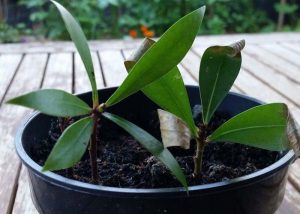 Borne in March – May, the fruit, liked by birds, is a globular berry, shiny purple to black, about 0.5cm in diameter clustered in axils at the end of branchlets. Both the leaves and the fruit contain a peppery and hot compound called polygodial which has been examined and written about in many scientific journals. It has some serious antifungal and antibacterial properties attributed to it, but of course, before using any medicinal plant please consult your GP and medicinal plant expert. The compound polygodial is also used as an insecticide for its antifeedant properties - it causes insects to starve. Reports that the plant has antioxidant and antidiabetic properties indicate that more research on medicinal use might be very useful.
Borne in March – May, the fruit, liked by birds, is a globular berry, shiny purple to black, about 0.5cm in diameter clustered in axils at the end of branchlets. Both the leaves and the fruit contain a peppery and hot compound called polygodial which has been examined and written about in many scientific journals. It has some serious antifungal and antibacterial properties attributed to it, but of course, before using any medicinal plant please consult your GP and medicinal plant expert. The compound polygodial is also used as an insecticide for its antifeedant properties - it causes insects to starve. Reports that the plant has antioxidant and antidiabetic properties indicate that more research on medicinal use might be very useful.
Propagation is easier from cuttings because it is possible to know what sex the plant will have.
Culinary uses
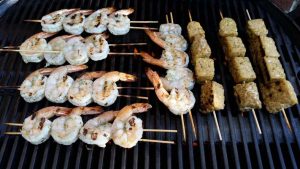
And here comes the fun part – how to use it in the kitchen. Recently I have been given some cuttings of the plant so that I can propagate it for my own use, and just for the record, I have had more success with the tip cuttings than the mid-section ones. Since there were a lot of the leaves left over, I decided to dry them and save them in my herb and spice collection, and just recently used it in one of the dishes I created for lunch on a warm Aussie Sunday afternoon. I wanted it to be as Aussie as can be, and what is more Aussie than a barbie?
I found beautiful Australian prawns at the market and marinated them in white wine and a mixture of Murray river pink salt and dried crushed T. lanceolata leaves. The final result was more than pleasing for the palate.
I can describe the taste as the mixture of bay leaf and rosemary, and the smell instantly reminded me of the Mediterranean. Whoever has walked along “lungo mare” in Italy, Croatia or any other Mediterranean country will know what I mean by that.
Just a few days later I tried the berries too. I combined them in a blender with some onions and mixed them through my vegetarian koftas, which proved to be a good choice. The berries taste almost the same as the leaves, except for the sweetness you get from the flesh surrounding the peppery seed. What I found interesting was that both the seed and the leaf had that peppery heat to them, but it seemed to disappear with cooking, leaving just the taste of Mediterranean behind.
If you live in a cool region of southern Australia you might like to grow T. lanceolata. And if you have a chance to use this wonderful herb, I’d say it’s really worth it.
References
- Cronin L. (2007) Cronin’s key guide to Australian trees. Australia: Allen & Unwin.
- Costermans L. (2006) Trees of Victoria and adjoining areas: Pocket book. 6th edn. Australia: Costermans Publishing.
- NationMaster http://www.statemaster.com/encyclopedia/Tasmannia (Accessed: 9 January 2017).
- Royal Botanic Gardens Victoria https://vicflora.rbg.vic.gov.au/flora/taxon/5505a156-251b-4f32-8711-f4e08c2ab9c2 (Accessed: 9 January 2017)."
Attracting Birds to your Garden
It's wonderful to watch and identify all manner of birds who have chosen to pop into the garden for a drink and a stickybeak. From tiny, cheerful little wrens and pardalotes, to the cheeky parrots, gorgeous honeyeaters and bossy wattlebirds, it's good to share space with our feathered friends. Just like a pot of basil and a shady spot, nothing makes a garden come alive like the twitter and chatter of a variety of Australian birds. They are essential in the garden, and not just to keep us backyard birdwatchers entertained, and there are many ways to attract them!
Get To Know The Neighbours
First things first: you need to know what kind of birds could be expected in your garden. There is no point designing a habitat for a bird that hasn't been seen in your neighbourhood for ages - or ever! Contact local bird watching groups to get an idea of what you should be attracting, and what is common to your area. You might be surprised. Some suburban gardens have been visited by over 46 species of bird over the years... that's impressive, and, with the right planning and processes, you may just be able to have that as well!

What about the cat?
Before adopting strategies to attract birds to your garden it’s worth thinking about cats. Are you enticing birds to their death? Suburban, rural and feral cats together kill many thousands of birds each night across the country. So if you or your neighbours own cats some thought is required.
Studies on suburban cats have reported different results on the role of cats as opposed to change in habitat in the decline of bird species diversity in suburbs. Reports of the numbers of birds killed and the effectiveness of attaching bells to the cat’s collar vary. What is clear, however, is that suburban cats do kill many thousands of birds and the bells are probably not making much of a difference. Interestingly, there is new idea, backed by research, that when cats wear a rainbow-coloured cloth collar, somewhat similar to that worn by clowns, with reflective strips, bird kills are significantly reduced. Apparently, because birds have highly developed eyesight this collar alerts them to the presence of a cat. Maybe worth a try?
What About The Water?
A source of water is absolutely essential in attracting birds and can significantly increase the number of species you will see. But like owning a cat, providing water is not without issues, and there are a couple of things that need to be considered when providing H2O.

Firstly, is it safe to swim? Are birds who visit your bird bath (or equivalent) able to gain access, have a drink and a paddle without fear of getting picked off by predators such as cats? Bird baths or ponds (preferably multiple drinking sites) need to be located so that, if startled or threatened, the birds can dart for cover in an adjacent “prickly” bush. Elevated bird baths – either on a stand or suspended from a tree – can help make birds safer.
Secondly, bird baths should be shallow enough to allow birds to stand in them to clean their feathers. It’s also helpful to choose baths that have sloping sides or to put stones at the edge to provide gradual access to the water.
Thirdly, the water has to be continuous. Birds remember where water sources are, and will seek them out, so ensure they are full all year round, and make sure you get someone to top them up for you while you are on holidays. The Bird Observers Club of Australia recommends that a shallow bowl, kept topped up, is ideal, and preferred by birds over deep ponds. Ideally, backyards should have a couple of water sources, each located by plants that will provide a nice bit of cover for smaller birds. They should be regularly cleaned out as well, to avoid transfer of disease and illness.
Is there a need to feed?
There is much debate about encouraging birds to your backyard through feeding! In the northern hemisphere, bird feeding is quite acceptable, but in Australia the view has been that, as tempting as it may be to put a bowl of budgie seed on the porch and watch the birds flock, this really doesn’t do the birds any favours. In fact, store bought seed mixes can make native birds a bit unwell (despite what the packet may say), but this is only one reason that feeding is discouraged by the majority of bird fanciers.
Birds can become extremely dependent on handouts at your house, and, as you take your annual holidays to the beach, your regular customers are suddenly without their main source of food for a couple of weeks, leading to… well, I think you know how you’d feel without food for a couple of weeks!
In addition, supplementary feeding creates further imbalance in delicate ecosystems, altering the natural behaviour of birds, favouring more aggressive birds in the backyard (while smaller birds in mixed feeding groups are more prone to predation) and assisting the spread of disease between birds. In short, it’s a contentious issue. Although throwing meat out for the Kookaburras or Magpies or putting out seed may seem to be encouraging birds to your garden, there will be no change in the diversity of species in the yard. In short, if you have Turtle Doves and Noisy Miners now, you’ll have more after feeding and perhaps even get introduced birds such as Common Starlings, Blackbirds, Indian Mynahs or House Sparrows.
Picking the Plants and Studying the Strata
So food may be out and the water's in! Lets have a look at the flora required to encourage feathered fauna. Essentially, a backyard brimming with botanic biodiversity is the one most likely to attract a variety of birds, especially if the plants are locally native. We're not suggesting you rush out and plant a whole swathe of enormous gum trees, although having some of these nearby does indeed help encourage the birds. The most important element of planting a bird habitat is to make sure all strata layers are accounted for. Strata layers are the differing layers of vegetation that essentially make up a habitat. As different birds (and other animals) live in different layers of vegetation, the more variety you can provide in the size and selection of plants you grow, the greater the variety of animals you may see turning up at your place. Different vegetation levels provide a diverse supply of food, shelter and safe spaces for birds, so consider a decent mix of ground covers, grasses, shrubs of varying sizes, and a couple of locally native tree species.
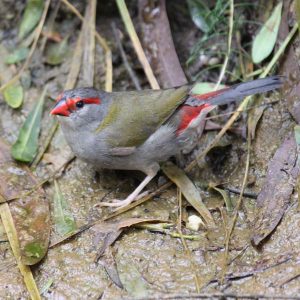 It's important to recognise that, like us, birds have different likes and dislikes when it comes to having a feed. Some birds are insectivorous, and will happily gobble away at all manner of creepy crawly critters, where as others are nectar lovers and seed swallowers. It's important, when planning your plants, to account for all appetites, and select plants that provide nectar, host insects, and provide shelter, as well as planning for vertical and horizontal structure.
It's important to recognise that, like us, birds have different likes and dislikes when it comes to having a feed. Some birds are insectivorous, and will happily gobble away at all manner of creepy crawly critters, where as others are nectar lovers and seed swallowers. It's important, when planning your plants, to account for all appetites, and select plants that provide nectar, host insects, and provide shelter, as well as planning for vertical and horizontal structure.
The following is a list of Australian native plants that are recommended within the backyard bird garden. That said, it's a great idea to check with your local indigenous plant nursery, bird observers group for their recommendations. As always, it's incredibly important to avoid invasive plants, especially those with bird attracting fruits. Where species name only is mentioned, it is important to source locally native variations of these plants.
Grasses - Provide seed, shelter and nesting material
- Poa labillardieri - Common Tussock Grass
- Themeda triandra - Kangaroo Grass
- Austrodanthonia sp. - Wallaby Grass
Groundcovers and Wildflowers - Provide nectar, seed, shelter and host insects
- Dichondra repens - Kidney Weed
- Kennedia prostrata - Running Postman
- Banksia sp.
- Grevillea sp.
- Hibbertia sericea - Guinea Flower
- Chrysocephalum sp. - Everlastings
Shrubs - Provide nectar, seed, shelter and host insects
- Acacia sp. - Wattle
- Correa sp.
- Bursaria sp.
- Leptospermum sp.
- Melaleuca sp.
- Callistemon sp. - Bottlebrush
Trees - Provide nectar, seed, shelter, nesting sites and host insects
- Eucalyptus sp. - Gum Tree
- Leptospermum sp.
- Melaleuca sp.
- Acacia sp. - Wattle
Can the Chemicals
Alright, the plants sorted, so what else do we have to do to encourage beautiful birds to our patch? Well, it's more a case of what not to do, especially when it comes to chemicals in the garden. Not all of us are completely at ease with "creepy-crawly-slimy-slithery-furry-flying" critters and insects in the garden, and tend to declare chemical warfare at the first sign of insect inhabitants. In order to keep a biodiverse, bird-friendly backyard, we need to seriously consider what chemicals we are using, and why. Insects and invertebrates (little tackers without backbones) are an incredibly important part of any ecosystem, and this includes mosquitoes, cockroaches, ants and spiders.
We have all heard of the butterfly effect, where a minor action in one location can have devastating "knock-on" effects elsewhere. Well, apply this to your backyard, where the sprinkling of ant granules or the spraying of pesticides could have a detrimental impact on not only the target insect, but a whole host of important invertebrates, with a further knock on to the critters that feed on these guys. A US study performed a few years back looked at about 80,000 dead birds that had been handed in to the Parks and Wildlife authorities in one state. Studies found that the bulk of these birds had been killed by pesticide poisoning, totally an astounding 65 million birds killed in the US each year. And it ain't much better here! Current studies into the rate of bird death from chemical poisoning is expected to reveal similar results. Think carefully about chemical use, and, where possible, avoid it altogether. After all, a couple of holes in a few leaves is all part of nature!
So, what are you waiting for? Attract those birds, and get recording. Keep a bird identification book and a diary handy to record those sightings, and become active in a local bird group - it's great fun, and you'll be amazed how addictive it is!
Want more info? Check out these links:
Plant Nutrients Explained

Although SGA recommends primarily using organic material such as compost and manures to promote fertility, it's worth thinking in more detail about plant nutrients. We know plants need them, we know things go wrong without them, we know gardening gurus can't stop talking about them, and we know certain combinations of them can cost us a mint at the garden centre. But what do they do, and what on earth are we paying for? Here is a list of plant nutrients, and why they are so important.
We Need to Talk about Concrete
Did you know that the environmental impacts of concrete are out of control and that the carbon dioxide produced from the production of concrete are a close second to fossil fuel emissions? Did you also know that concrete is the second most consumed substance on earth after water?
Alison Aplin, award winning landscape designer (Winner 2014, 2016 Landscaping Victoria ‘The Sustainable Landscape’) tells why she refuses to use concrete.
How is this relevant to gardens?
“As a sustainable landscape designer, designing and implementing gardens for over 20 years, I believe that it is time that we considered the massive environmental impacts that many landscape designers are causing through the use of concrete. It is composed primarily of cement - a powdery substance derived from the process called calcination where calcium carbonate decomposes to form calcium oxide with the release of carbon dioxide. Concrete is formed when cement is mixed with clay, water, sand and gravel.
 Cement manufacturing is highly energy – and emissions - intensive because of the extreme heat required for its production from calcium carbonate. The energy used comes largely by burning coal and gas which converts the energy stored in them to heat with the release of carbon dioxide. The first law of thermodynamics states that energy can be transformed from one form to another, but is unable to be created or destroyed. So further concrete production requires use of more and more of declining resources of coal and gas and that cannot continue indefinitely.
Cement manufacturing is highly energy – and emissions - intensive because of the extreme heat required for its production from calcium carbonate. The energy used comes largely by burning coal and gas which converts the energy stored in them to heat with the release of carbon dioxide. The first law of thermodynamics states that energy can be transformed from one form to another, but is unable to be created or destroyed. So further concrete production requires use of more and more of declining resources of coal and gas and that cannot continue indefinitely.
Concrete is used throughout the building industry for homes and commercial premises. It is the most widely used building material because of its strength in many situations. So if this use continues, then the external element, within gardens, needs to be considered. Is its outside use appropriate?
Because of my strong ethic, I refuse to provide rendered retaining walls in gardens, especially on flat sites, so that the site can be significantly modified in order to take the plants that the designer wants to grow. This is not how it should be done.
Sustainable gardens last for a reason, whereas so many gardens with modification to the site i.e. rendered walled gardens with fancy paving over concrete bases, are not the way to go. The plants in these gardens often collapse after a few years because of the site has been completely changed from its natural condition. This is strongly atypical of a normal garden – it is not clever garden design. But this approach of landscape architects and landscape designers is becoming the norm. I firmly believe that because of the massive increase in concrete use, this practice needs to be controlled now.
What can we do about it?
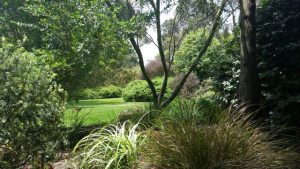 The right way to design a garden, and this is my opinion, is to suit the plant to the site and soil as in my garden on the right. Not modify the soil to suit the plant that you want to grow. It’s the same as a person wanting to grow camellias where they have alkaline soil. The naïve will try to change the pH of the soil by adding sulphur or peat – this is a very slow process. Why not put the camellia in a pot where the soil can be regulated properly? And then put a plant in the ground that is suited to that position – and it should thrive!
The right way to design a garden, and this is my opinion, is to suit the plant to the site and soil as in my garden on the right. Not modify the soil to suit the plant that you want to grow. It’s the same as a person wanting to grow camellias where they have alkaline soil. The naïve will try to change the pH of the soil by adding sulphur or peat – this is a very slow process. Why not put the camellia in a pot where the soil can be regulated properly? And then put a plant in the ground that is suited to that position – and it should thrive!
According to the Concise Oxford Dictionary, a ‘garden’ is ‘a piece of ground devoted to growing flowers, fruit or vegetables’. There is no mention of rendered, raised planter boxes or concrete en masse. A garden is about plants.
As a designer there are so many more sustainable alternatives to concrete – it’s just a matter of changing direction and taking the client with you. If you have a passion, and confidence in what you are talking about, the client will respect the advice when sustainable alternatives are suggested and the reasons explained. This conversation needs to start – with the landscape architect, landscape designer and the general public requesting gardens that are composed of concrete.
We all really need to start becoming more aware of the excessive use of concrete. And it is excessive. We need to start the conversation with others about this worldwide problem – it has to stop. We are all now fully aware of the impacts of fossil fuels, with the exception of those who lack any capacity for common-sense, so we need to make the world more aware of the effects of concrete. It is a major global problem that, in my opinion, needs addressing now.”
Alison Aplin, Timandra Design & Landscaping
Some Useful Bushfoods
Over the last years gardens (and gardeners) have undergone a revolution of sorts. Water restrictions, climate change and rapidly disappearing native habitats has prompted a resurgence in native gardens. While rising food and petrol prices (amongst other things) have seen gardeners returning to home produce gardening. But, how to combine the two successfully?
Well, just like parmas and pots, Sonny and Cher, pies and footy, John and Yoko (ok, maybe not), it is possible to grow both native and food gardens in perfect harmony. Welcome to the wonderfully tasty world of bush foods - fun with flora for the whole family!
Think about it this way - locally native (indigenous) and non-invasive native plants are perfectly adapted to our climate, soils and rainfall. So much so that there is very little (if any) need for added inputs like pesticides and fertilisers. Sustainable enough on their own but wait, there's more!
Native plants (especially those indigenous to our local area) create much needed habitat for a huge array of displaced native critters (both large and small), contribute to the unique local character of an area, look fantastic and, if we plant the right mix, can provide the gardener with a bounty of beaut bush food.
So, what to plant, where to put it, what to do with it, and, most importantly, what does it taste like? Indigenous Australians traditionally had a massive smorgasbord of bush foods to choose from, many of which required the entire plant to be removed in order to get to the tubers and roots. This is obviously not ideal for many home gardeners but, for the adventurous, some of these are definitely worth a crack!
The other point I'd best raise here is that many of the traditional bush food staples taste pretty ordinary to our 21st century, multicultural and additive-addicted food palates. I don't mean to sound like Gordon Ramsay here (they'd never publish me if I did!), but I'll admit that for me some bush food offerings are an acquired taste. Traditional owners of this land appreciated these foods on an entirely different level and they thrived on them.
As home gardeners though, we tend to grow bush foods that look good, taste good and add that little "something special" to a meal. So, prepared for you is a platter of possible plants to whet your palate!
Grasses and Wildflowers

Wahlenbergia communis (Tufted Bluebell)
Pictured Right (All mainland states) Small perennial wildflower to 30cm. Needs well-drained soils, will tolerate semi-shade. Light blue to lilac flowers are edible, and fantastic in salads.
Arthropodium strictum (Chocolate Lily)
(Tas, SA, Vic, NSW) Grass-like seasonal wildflower, 70cm x 50cm. Needs well-drained soils. Purple chocolate scented flowers are an excellent addition to salads. Indigenous Australians ate the tubers.
Dianella longifolia (Pale Flax Lily)
(All States) Hardy, easily maintained grass-like wildflower. 80cm x 50cm, needs well drained soils. Clumping. Dark blue to purple berries are edible when ripe. Berries sweet and juicy (slightly gritty). Great addition to fruit salad.
Dianella revoluta (Black Anther / Flax Lily)
(All States except NT) Hardy, easily maintained grass-like wildflower. 80cm x 50cm, needs well drained soils. Clumping. Dark blue to purple berries are edible when ripe. Berries sweet and juicy (slightly gritty). Great addition to fruit salad. Leaf base (white) also edible, starchy in taste.
Groundcovers and Herbs
Carpobrotus rossii (Coastal Pigface)
(Vic, Tas, SA, WA) Hardy, succulent groundcover. Needs dry, well-drained soil. Full sun Round, sweet, purplish fruits eaten raw in summer. Leaves also eaten, but are often salty.

Kennedia prostrata (Running Postman)
Pictured Right (All states except NT) Prostrate ground cover to 2m wide. Hardy, needs dry, well drained soil. Scarlet pea-type flowers sucked to extract sweet nectar.
Rubus parvifolius (Native Raspberry)
(Vic, Qld, Nsw, Tas, SA) Scrambling ground cover to 2m wide. Needs well-drained soils, full sun. Small, sweet, deep red berries from Dec - April. Leaves, when made into tea, said to treat diarrohea.
Tetragonia tetragonioides (Warrigal Greens)
(All States except NT) Leafy ground cover to 1.5m wide. Moist, free draining soil, part shade. Should be controlled in gardens to monitor invasiveness. Leaves are edible raw or cooked. Young leaves are less bitter, and an excellent spinach substitute.

Viola hederacea (Native Violet)
Pictured Right (Vic, Qld, NSW, Tas, SA) Creeping, mat forming groundcover. Needs a moist spot, and some shade. Delicate white and purple flowers are edible, and make salads look amazing!
Shrubs and Climbers
Austromyrtus dulcis (Midgen/Midyim Berry)
(Qld, NSW) Spreading shrub to 2m tall. Needs moist, well-drained soils. Partial shade, protect from frost. One of the best! The white berries (with purple spots) are deliciously sweet, and melt in the mouth!
Billardia scandens (Climbing Apple Berry)
(Vic, Qld, NSW, Tas, SA) Soft climber, but will become bushier in open positions. Tolerates a range of soils, from well-drained to moist. Grows well under large trees. The small green fruits are edible, and are surprisingly sweet and refreshing. Would be great in fruit salad.
Coprosma quadrifida (Prickly Currant Bush)
(Vic, NSW, Tas) Upright, spiny shrub to 2m x 1.5m. Needs, moist, well-drained soil, protected site with partial shade. Tiny red fruit is edible, with a sweet, slightly tart taste. Can be eaten raw or cooked.

Einadia nutans ssp. nutans (Climbing or Nodding Saltbush)
Pictured Right (All States except WA) Spreading, low growing shrub to 1.2m. Prefers warm, dry position. Full sun. Attractive small red berries are incredibly sweet. Leaves can also be eaten, boil first to remove salt.
Hibiscus heterophyllus (Native Rosella)
(Qld, NSW) Attractive, rounded shrub to 2m. Needs well moist, drained soil. Partial shade. Protect from frost. Buds cooked and made into rosella jam. Buds can be eaten raw in salads or boiled as a vegetable. Petals can be eaten in salad.
Prostanthera ovalifolia (Oval Leaf Mint Bush)
(Qld, Vis, NSW, SA) Dense, rounded shrub to 2m. Moist, well drained soils. Some shade. Leaves have delightful mint aroma, excellent in jams, jellies and as a tea.
Trees
Backhousia citriodora (Lemon Myrtle)
(Qld, NSW) Small, low branching tree, 3m - 8m. Needs warm, well-drained soil. Full sun to part shade. Protect from frost. Intense lemon flavoured leaves. Excellent in teas, or as a lemongrass substitute. Great in cheesecakes. Dry and ground for cakes and biscuits.
Citrus australasica (Native Finger Lime)
(Qld, NSW) Small tree, 4m - 6m. Full sun to part shade, moist, fertile, well-drained soil. Great in pots. Finger shaped fruit is filled with edible caviar sized balls. Delightful lime taste, excellent in Asian dishes and cocktails. A real winner!
Macadamia integrifolia (Macadamia Nut Tree)
(Qld, NSW) Rounded tree, generally to 12 - 15m. Can be slow growing. Grafted varieties available in many parts Aus and NZ, and are preferable for quality and growth habit. The nuts borne on this tree are absolutely delicious, and many a Queenslander has memories of summer days spent cracking nuts on the back verandah! They must be tried to be believed!
Syzygium luehmannii (Riberry)
(Qld, NSW) Small bushy tree to 8m. Well drained fertile soil. Full sun to semi shade. Sweet purple berries with tart aftertaste. Excellent in jams, as a sauce for meat or as a cordial.
Tasmannia lanceolata (Mountain Pepper)
(Tas, Vic, NSW) Bushy shrub to 3m, needs deep rich soil, some shade. Protect from wind. Leaves and berry are both edible as a hot, hot, hot substitute for black pepper. Can be used fresh or dried. Great for seasoning meat and casseroles.
This list is, of course, just a small selection of Aussie bush foods, many of which are readily available from your local indigenous and native nurseries (or really good garden centres). Check out some of the links below to see what you can grow (and where you can track them down) in your part of Australia.
One final thought - I often get asked how our Indigenous Australians knew what they could and couldn't eat... the short answer is "trial and error". With that in mind, don't go chowing down on every berry, leaf and the like you see on your next bush walk. While heaps of stuff is perfectly safe to eat, there is a fair bit that will make you pretty sick... or worse! So play it safe when you're in the bush... take a cut lunch instead!!
Find out more or buy plants?
Links around Australia:
Goldfields Revegetation Nursery, Bendigo, Victoria www.goldfieldsrevegetation.com.au.
South Australian Native Food Association .
Bushfood Factory, WA www.bushfood.biz.
Allora Gardens Nursery, Darwin, NT www.alloragardensnursery.com.au.
Habitat Plants, Liffey, Tasmania habitatplants.com.au.
References:
Australian Plants Society of Maroondah (2001), Flora of Melbourne, 3rd Edition, S.G.A.P Maroondah, VIC.
Smith, K & Smith, I (1999) Grow Your Own Bushfoods. New Holland, Sydney NSW.
CSIRO Sustainable Ecosystems Australian Native Foods
Rural Industries Research and Development Corporation The New Crop Industries Handbook
Protecting Plants in Hot Weather
As our climate warms and the frequency of very hot days increases, the risk of plants being damaged increases too. It’s good to start thinking about this before the really hot days hit so that you are ready with your defences. There are some simple, sustainable and cheap methods of giving your plants some protection - you don’t need a special shade house, just some ingenuity and a bit of forward planning so that you are ready when the heat arrives.
Keep Moisture Levels High
For some plants, high temperature alone, without direct sun, can be sufficient to cause wilting and even death because of evaporation from the stomates (pores) in leaves. However, if you can give plants a good watering before the sun rises, or the night before, plants will take up moisture and be more resistant to the day's heat. Watering systems which deliver water to the ground rather than leaves are preferable. You may need to water the ground again during the day, but make sure water does not get on the leaves because that can induce scalding as it evaporates.
Mulch Well
We probably don't need to say this to a sustainable gardener, but be sure to cover the soil and irrigation systems with a thick layer of mulch. This will shield soil from sun and reduce evaporation from the soil surface.
Provide Extra Shade
Most Australian native plants and Mediterranean plants, such as rosemary and thyme, can withstand high temperatures as long as they have some water. It is really vegetables, fruit trees, vines and tender annuals and shrubs which need extra care. Garden centres and nurseries usually use shade cloth screens which can be rolled out over plants during the day. You could opt for that in your garden or buy a ready-made shade house. For occasional heatwaves, however, it is much more sustainable to use methods which are versatile, demountable, use recycled or natural materials and are easily modified.
Temporary shade can be created by attaching shade cloth to systems of stakes over plants in direct sun. Plants receiving afternoon sun might benefit more from having a shade cloth screen on the west of the garden bed. If there are handy walls or fences, you can suspend shade cloth from them to stakes in the garden. The colour of the cloth is not always the best guide to its shading capability, so look for 50 – 90% shading. For vegetables and fruit trees 50 – 60% shading is usually adequate, but for sensitive and ornamental plants, 70 – 90% is needed.
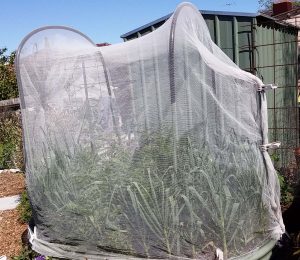 Fine netting used to protect plants from birds, possums, rats and certain harmful insects also contributes some shade - generally 18 – 20 % shade. It also reduces the effects of wind. Its use, thus, has multiple purposes and, on extremely hot days, extra protection can be given by clipping shade cloth on as well. The picture at the right shows use of fine netting on vegetable beds.
Fine netting used to protect plants from birds, possums, rats and certain harmful insects also contributes some shade - generally 18 – 20 % shade. It also reduces the effects of wind. Its use, thus, has multiple purposes and, on extremely hot days, extra protection can be given by clipping shade cloth on as well. The picture at the right shows use of fine netting on vegetable beds.
Constructing frames specifically for shade does not need to be expensive or difficult. And it can be really sustainable if you source materials from tip shops, op shops or your own castoffs. Relatively short lengths of polypipe slid over bamboo sticks are very inexpensive, easy to assemble, portable and easily adjustable. An example is shown below at the left. We have found that short, thin bamboo stakes available from hardware stores are just right. 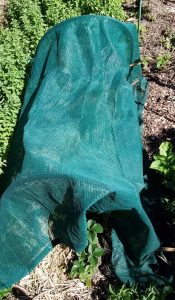 Attach some polypipe of appropriate diameter (it doesn’t need to sit tightly) to make a hoop leaving some bamboo exposed at the base. Clip shadecloth to the bamboo using ordinary clothes pegs (they won’t fit on the slightly wider polypipe). The biggest expense here is the shade cloth, but you can re-use it year after year, or you might find some at the local tip.
Attach some polypipe of appropriate diameter (it doesn’t need to sit tightly) to make a hoop leaving some bamboo exposed at the base. Clip shadecloth to the bamboo using ordinary clothes pegs (they won’t fit on the slightly wider polypipe). The biggest expense here is the shade cloth, but you can re-use it year after year, or you might find some at the local tip.
What about old curtains or sheets?
Using such materials is an excellent way of repurposing cloth. If you don't have any, ask you mother! Or visit and Op Shop - they usually have a lot at very reasonable prices. You could drape them over frames or just hang them over shrubs. However, since in many parts of the country, heat is often accompanied by strong wind, it's a good idea to peg them down.
Umbrellas
Get out the beach umbrella as well as those you use for rain. With the aid of some stakes or bamboo sticks these can be placed strategically.
Protect the Sides of Raised Beds
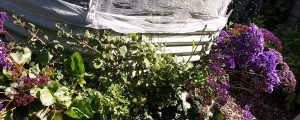 Sun beating down on the side of a raised bed, particularly if made of metal which conducts heat, can lead to hot soil. Try growing heat tolerant plants on the outside of raised beds. In the picture on the right are Plectranthus and Limonium (Statice). Keep them pruned so they grow tall and sideways rather than outwards remaining close to the edge of the bed. Don’t grow plants which have underground runners like marjoram or yarrow - they will migrate under the edge into the bed, steal nutrients from the soil and be difficult to remove. If you don't like the informal look in the picture, you could try growing a narrow hedge of something useful like myrtle Myrtus communis - it is easy to grow and can be pruned to shape. And its peppery berries can be used to flavour roast chicken or pork or infused in alcohol for an interesting tipple.
Sun beating down on the side of a raised bed, particularly if made of metal which conducts heat, can lead to hot soil. Try growing heat tolerant plants on the outside of raised beds. In the picture on the right are Plectranthus and Limonium (Statice). Keep them pruned so they grow tall and sideways rather than outwards remaining close to the edge of the bed. Don’t grow plants which have underground runners like marjoram or yarrow - they will migrate under the edge into the bed, steal nutrients from the soil and be difficult to remove. If you don't like the informal look in the picture, you could try growing a narrow hedge of something useful like myrtle Myrtus communis - it is easy to grow and can be pruned to shape. And its peppery berries can be used to flavour roast chicken or pork or infused in alcohol for an interesting tipple.
Relocate Pots and Seedling Trays
Find shady spots under shrubs or trees to temporarily place potted plants. You could even take them inside the house for the day.
Keep Your Plants Healthy
Resilience to extreme weather is improved by healthy plants which have adequate nutrition and water. And healthy plants are what you wanted anyway!
Tips for Starting an Organic Garden
Just beginning to garden on an empty piece of land? Or making over an existing one? It can be confusing if you consult magazines or websites to know where to start since many, even SGA’s, have articles on single topics without an indication of which are more important. Phil Mackie and Gwen Kestrel give us tips on what to focus on right from the start.
They each garden in different climates and with very different plants. They’re co-workers for an online company, but they bonded over shared hobbies, including gardening. They believe that sustainable gardening without the use of pesticides and chemical fertilisers should be the goal of all gardeners. Although their gardening backgrounds are different, their crops vary, the pests and diseases that threaten their crops vary, they’ve found strategies that are absolutely true for each of them to have the healthiest garden possible.Read more
Green Thumb
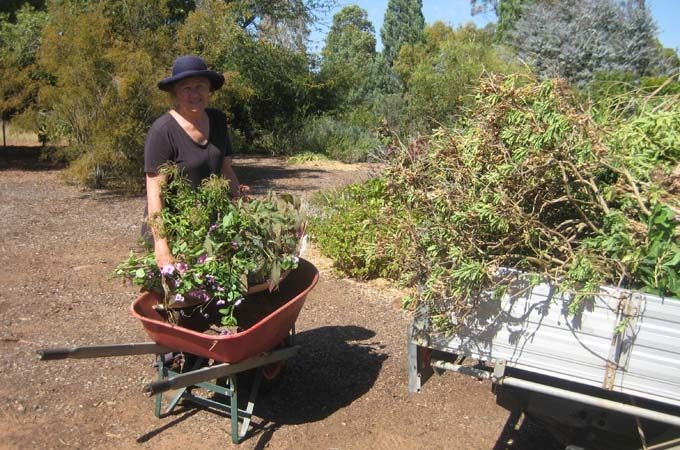
Do you have a "green thumb" or aspire to one? Do you think that people who have a "green thumb" have just been born that way? Jane Ryrie, a keen gardener, gives us a humorous insight in her poem.Read more
Decorative and Productive
This garden is for the soul as well as the stomach - a delight to all the senses. Visually gorgeous in any season, with spectacular camellias in winter through to the cottage-style plantings and roses throughout the rest of year, it is obvious that Valerie gets great delight in having something beautiful to enjoy from the house. Even without the extensive produce, the garden provides colour and interest as well as food.
Valerie moved to this quarter acre block in in Eltham, Victoria, in 1983 with absolutely no gardening experience or knowledge. The house was 1 year old and was built on 7 feet of rock and clay fill. It was very ugly. The decision was to have an English style cottage garden. The neighbours said that it would be impossible. However, the land was rotary hoed, clay breaker (gypsum) and truck loads of good topsoil were brought in. Valerie had tested all the imported soil first before purchasing with a pH testing kit because the ornamentals she wished to grow were acid-loving. Over the last 7 years, the garden has evolved from an all flowering garden to include a range of edibles with organically grown fruit, vegetables and herbs intermingled with flowering plants and trees.
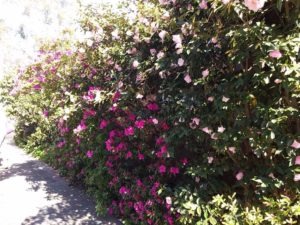 The drought some years ago caused most of the rhododendrons to die because it became too costly to use the town water for the automatic watering system. A 37,000 litre water tank was then installed to feed an a solar powered irrigation system. It took about a year to have all the downpipes from the house and garage connected to the tank and four connections for hoses installed. It was well worth it.
The drought some years ago caused most of the rhododendrons to die because it became too costly to use the town water for the automatic watering system. A 37,000 litre water tank was then installed to feed an a solar powered irrigation system. It took about a year to have all the downpipes from the house and garage connected to the tank and four connections for hoses installed. It was well worth it.
Over the past five years an elm tree (affected by the elm leaf beetle) and a very large liquid amber tree were removed, amongst other shrubs, to make way for the edible garden. This has resulted in a sunny back yard to take advantage of the fact that the main aspect is facing north-east - a great advantage for growing fruit and vegetables.
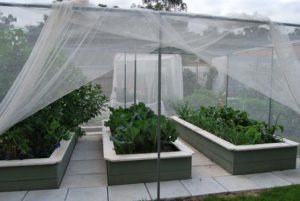 Valerie’s husband, John, is a very good carpenter. First he built the 4 raised vegetable beds and completely netted enclosures for fig and avocado trees. Because so much damage was done by white cabbage moth larvae last year, he erected high enclosures to exclude pests while still having easy access to work in. These enclosures are very sturdy to withstand the test of time.
Valerie’s husband, John, is a very good carpenter. First he built the 4 raised vegetable beds and completely netted enclosures for fig and avocado trees. Because so much damage was done by white cabbage moth larvae last year, he erected high enclosures to exclude pests while still having easy access to work in. These enclosures are very sturdy to withstand the test of time.
The idea of espaliering fruit trees to make good use of available space was very attractive so now they have 10 different espaliered fruit trees, two of which are 2 way trees. These espaliers also serve to create “rooms”. Throughout the garden they have tried to use as many sustainable systems as possible. Heirloom seedlings and seeds are used where available. In the development of the garden they discovered that different plants have different needs, e.g. some require high nitrogen soil content whilst others require less but more potash – so they plant accordingly. They have incorporated worm farms within the vegetable beds, use crop rotation, homemade compost and mulch to provide organic matter to the soil. Blood and Bone and pelleted manure add boost fertility as do the lupins which fix nitrogen.
Snails, slugs, pear and cherry slugs and white cabbage moths seem to be the worst enemies. Coffee grounds and crushed egg shells have been used with some success to keep the snails and slugs at bay.  Careful observation of all plants is a daily habit. Seaweed extract has been a good ally to strengthen plants to help withstand attack and there is an insect hotel and plenty of flowers to attract beneficial insects.
Careful observation of all plants is a daily habit. Seaweed extract has been a good ally to strengthen plants to help withstand attack and there is an insect hotel and plenty of flowers to attract beneficial insects.
They particularly like the fact that there are flowers for all seasons and that it is possible to have beans for 5 months successive plantings. They enjoy picking vegetables when they are required and the really fresh taste of organically grown produce – perfect for John who loves cooking good food with fresh produce. The fruit trees are prolific so that stone fruit can be preserved and enjoyed all year round or made into jam which makes good presents.
All of this is even without mentioning the stunning trompe l’oeuil set off by the wisteria arbour and surrounding shrubs.
A list of the trees and some of the permanent plants within the garden
|
|
|
|
Heart in Garden
Nicla Byrnes writes:
 Gardening is more than soil and productivity. It is frequently much more profound - intersecting with personal experiences, human interactions and sociological change. I was at my local nursery recently buying violets as a gift, African Violets. But found myself transported into childhood memories and witness to a touching experience of love and generosity by an older lady who reminded me of my grandmother.
Gardening is more than soil and productivity. It is frequently much more profound - intersecting with personal experiences, human interactions and sociological change. I was at my local nursery recently buying violets as a gift, African Violets. But found myself transported into childhood memories and witness to a touching experience of love and generosity by an older lady who reminded me of my grandmother.
Because it was February and my friend’s birthday motif is all purple and gold, African Violets seemed appropriate and I love violets. Who would have thought then of frangipanis? It was this older lady in the nursery who reminded me. She seemed distressed, distressed by her frangipani tree. How is that possible, for the frangipani is surely loved by most people? Everyone loves frangipanis, well just about anyway. It turns out, she loved frangipanis too. I don't blame her. What's not to love about a frangipani: relatively small but that's okay, resilient, tropically darling, that distinct ambrosial scent, often pearly white and milky fresh with yolky centres. The flowers appear from December to April in Australia. You can barely burn a frangipani because they are determined to love the sun and I love that about frangipanis.
Like the shutters opening and closing on a summertime window, I saw pictures of childhood holidays in Coffs. Oh it was something beautiful up there. Doreen, my grandmother on Dad's side, built her home in Coffs Harbour. It was before too many high-rise giants. It was like a country town back then. It was like plonking Hawaii into the outback a bit. There was so much sweet fruit and coloured flowers and beaches, beaches stretching miles and lapping waves and hilly topped banana plantations. I loved those days. It was a home away from home. I loved my grandmother on that side too, very much, and her sister Nancy. Nancy was a real gem. She loved me a lot. I felt that love and holidays then were something pretty magical to look forward to.
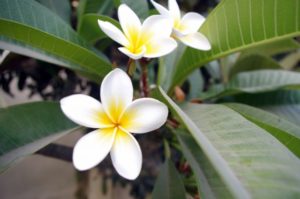 Drifting back to the present, the lady in the nursery was upset because a stranger had broken away branches from her beloved frangipani tree, possibly children thinking it was a bit of a lark. She was sharing a photograph with the sales assistant. She wanted advice on saving the broken branches. My first thought was that I was in a hurry and why would she hold the queue up with a long drawn-out story about a couple of frangipani branches. The rest of the tree was still in tact, but then I stood back and listened to the story and it got me wondering. It got me wondering about why she might not just buy another tree and whack it in the ground whole or leave the main part of the original to regrow. It struck me then that she was most probably not very rich, that it might not even be an option to buy copious amounts of new trees and flowers. In fact, while our system here in Australia for the aged is better than some, it would be quite impossible at times, to live off a pension and still have money spare for luxuries such as frangipani trees. Then it struck me that there was much more to the story too.
Drifting back to the present, the lady in the nursery was upset because a stranger had broken away branches from her beloved frangipani tree, possibly children thinking it was a bit of a lark. She was sharing a photograph with the sales assistant. She wanted advice on saving the broken branches. My first thought was that I was in a hurry and why would she hold the queue up with a long drawn-out story about a couple of frangipani branches. The rest of the tree was still in tact, but then I stood back and listened to the story and it got me wondering. It got me wondering about why she might not just buy another tree and whack it in the ground whole or leave the main part of the original to regrow. It struck me then that she was most probably not very rich, that it might not even be an option to buy copious amounts of new trees and flowers. In fact, while our system here in Australia for the aged is better than some, it would be quite impossible at times, to live off a pension and still have money spare for luxuries such as frangipani trees. Then it struck me that there was much more to the story too.
The Sales Assistant looked to me frustrated by the hold up in proceedings but I wasn't in a hurry now.
"No, no, don't mind me. I'd like to learn about saving the frangipani branches too. They can be propagated from cuttings right? "
" Yes, you could do that. Let me check with our horticulturalist to be sure," she replied, still a little concerned by the slowing of a busy day and preoccupation to get on top of time. Ironically the garden will teach you that time won't hurry up always in ways you might want and that's okay and that's actually pretty great.
It turned out, you can save frangipani branches.
"It was a very important tree," she said to me, the lady in the nursery. "It was a gift. It was a gift from someone I knew. It was a very important tree."
And I knew then, it had come from a very important person.
The sales assistant went to collect some soil that might help with propagation and then the lady stopped her...
"Could I come back? Could I come back with the branches and someone who knows how to plant them might help me? "
And I knew then it wasn't just about the frangipani tree. All of us search for healing or love through community and connections and the nursery was going to help nurse her soul. As corny as it might sound, it was true and it is true because they said "Sure, come on in. We'll give you a hand."
This was in a smaller nursery with perhaps more room for love and less concentration on "productivity" and spreadsheets metering success but it got me thinking. It got me thinking that there's no reason why a larger nursery might not continue to foster this kind of connection. It's because money's pretty dull if you have to serve yourself. And the best shine comes off people and the sun of course.


